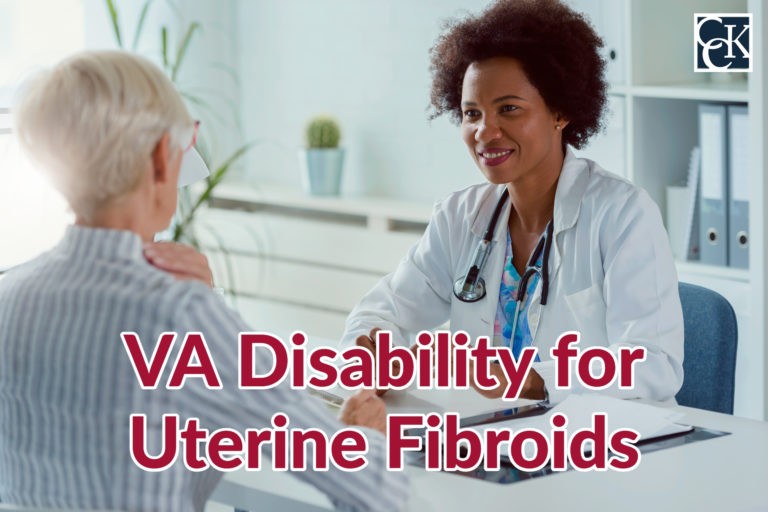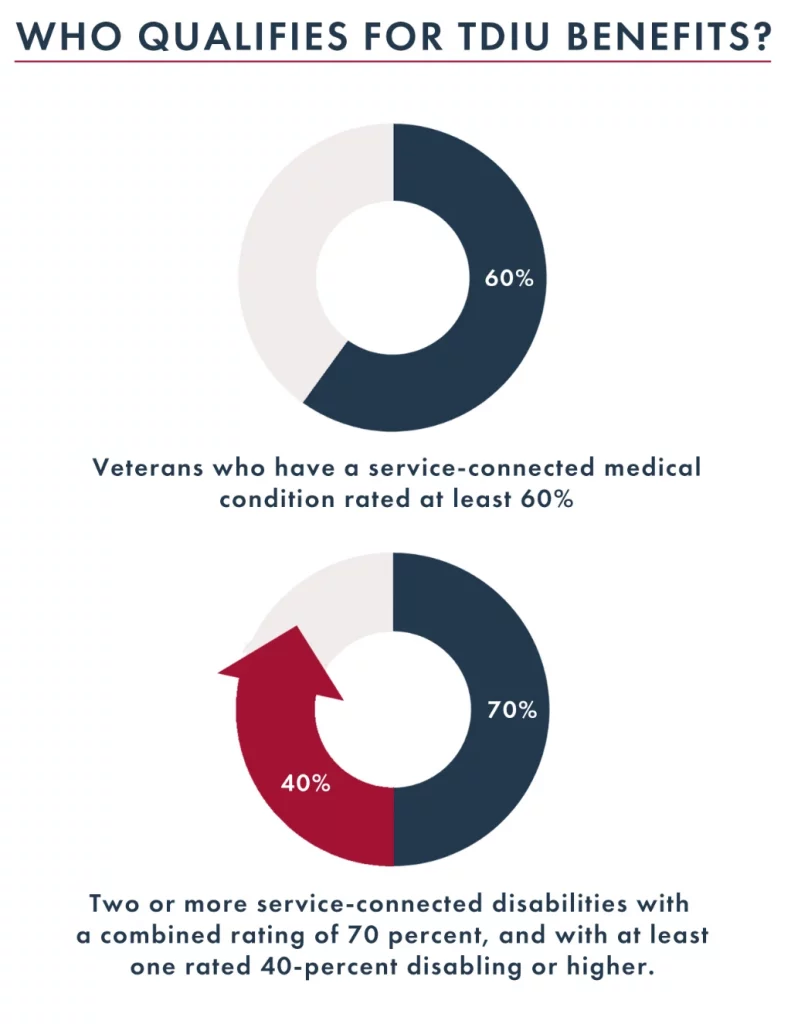VA Disability for Uterine Fibroids

CCK Law: Our Vital Role in Veterans Law
Uterine fibroids are a condition that many people have, often without even knowing it. The condition often goes undetected because it can occur without symptoms. However, people who do experience symptoms may face lower back pain, difficulty urinating, and changes in menstruation. If you are a veteran who has uterine fibroids which can be connected to your military service, you may be entitled to VA disability compensation.
What Are Uterine Fibroids?
Uterine fibroids are growths developed from muscle tissue of the uterus. They are benign, meaning not cancerous, but they can still cause some adverse symptoms. Uterine fibroids can grow inside or outside of the uterus or be attached to the uterus by a stem-like structure. A person can develop one or many uterine fibroids, and they can vary in size.
Symptoms of Uterine Fibroids
According to the American College of Obstetricians and Gynecologists, symptoms can include the following:
- Longer, heavier menstrual periods
- Intense menstrual pain or cramps
- Vaginal bleeding outside of menstruation
- Blood loss or anemia
- Low back pain, which can be dull and aching or sharp
- Abdomen pain
- Pain during sexual intercourse
- Difficulty urinating or frequent urination
- Constipation or difficult bowel movements
- Enlarged uterus and abdomen
- Miscarriages or infertility
How Are Fibroids Diagnosed?
Fibroids are often first diagnosed during a pelvis exam. There are also several tests which can be used to further analyze uterine fibroids, such as:
- Ultrasonography
- Hysterscopy
- Hysterosalpingography
- Hysterosalpingography
- Sonohysterography
- Laparoscopy
Imaging tests can also be used to track how fibroids grow and develop over time.
What Treatment is Available?
Typically, no treatment is required for uterine fibroids that do not cause symptoms. However, when symptoms are severe, surgery or medication may be necessary.
Service Connection for Uterine Fibroids
If a veteran has uterine fibroids which can be connected to their military service, they may be entitled to compensation. First, however, the veteran must establish service connection. To do so, veterans will need to submit the following:
- A current diagnosis of uterine fibroids; AND
- Evidence of an in-service event or stressor which caused or contributed to the veteran’s uterine fibroids; AND
- A nexus which links the veteran’s in-service event or stressor to the uterine fibroids
To file a claim for service-connection, veterans also need to submit VA Form 21-526EZ. This form can be submitted in person at a Regional Office, online using VA’s EBenefits portal, or through an accredited representative.
VA Compensation & Pension Exams
After a claim for uterine fibroids has been filed VA may request that the veteran attend a Compensation & Pension (C&P) examination for VA to assess the cause and severity of their condition.
During the examination, a VA gynecologist or healthcare professional will ask the veteran questions about their condition and what symptoms they are experiencing. Once a diagnosis is established, the VA examiner will provide an opinion as to whether the veteran’s condition is “at least as likely as not” due to their time in service.

How Does VA Rate Uterine Fibroids?
VA does not have a specific diagnostic code used to rate uterine fibroids. However, if a veteran has uterine fibroids linked to their military service, VA will rate the condition analogously.
Analogous ratings are ratings given to conditions that are not explicitly included in the VASRD, or VA’s Schedule for Rating Disabilities. Analogous ratings are assigned based on what condition most closely matches the overall symptoms or treatment of the disability that VA is trying to rate.
For example, uterine fibroids are most often rated using Diagnostic Code 7613 38 C.F.R. § 4.116. This diagnostic code is diseases, injuries, or adhesions of the uterus. The ratings which can be given are as follows:
- 30%–Veterans whose symptoms related to uterine fibroids are not controlled by continuous treatment are assigned this rating.
- 10%–This rating is given to veterans whose symptoms of uterine fibroids require continuous treatment.
- 0%–Veterans with symptoms that do not require continuous treatment can be assigned a 0 percent rating. Although this rating is non-compensable, meaning veterans do not receive monthly compensation, it is important because it establishes service connection which can be helpful in securing an increased rating later on.
Secondary Service Connection and Uterine Fibroids
Secondary service-connected condition is a form of service connection for veterans who have a condition that is caused or aggravated by an already service-connected condition. Uterine fibroids may be both a condition that is secondary to another condition or one to which another condition can be secondary service connected.
For example, sometimes if a veteran has severe symptoms associated with uterine fibroids, they may need to undergo a hysterectomy. A hysterectomy is an operation that is performed to remove the uterus. Sometimes a veteran with uterine fibroids may need to undergo a total or partial hysterectomy. As such, these veterans .may be eligible to receive benefits for a hysterectomy secondary to uterine fibroids.
To submit a claim for secondary service connection, veterans will use the same form as form as for primary service connection (VA Form 21-526EZ). Veterans will also need to submit:
- A current diagnosis of the secondary condition;
- Medical evidence linking the secondary condition to uterine fibroids
If the veteran is seeing secondary service connection for uterine fibroids, they will submit a current diagnosis and medical evidence linking the fibroids to their primary service-connected condition.
TDIU and Uterine Fibroids
TDIU is a VA benefit available to veterans who are unable to gain or maintain substantially gainful employment because of their service-connected disability. This benefit pays veterans at the 100 percent rating level, even if their combined disability rating is less than that.
There are generally two ways to be eligible for TDIU:
- 38 CFR § 4.16a (“Schedular”) – For this form of TDIU, the veteran must have:
- One condition rated at minimum 60 percent OR
- Two conditions that can be combined to reach 70 percent, where one condition is at minimum 40 percent
- 38 CFR § 4.16b (“Extraschedular”) – This form of TDIU is for veterans who may not be able to achieve the ratings necessary for schedular TDIU but are still unable to obtain substantially gainful employment on account of their conditions.
With uterine fibroids, ratings given could help contribute to a veteran’s schedular TDIU eligibility. For example, if a veteran is service connected at 30 percent for their uterine fibroids and at 40 percent for another condition, they would be eligible for TDIU. However, since the highest rating given for uterine fibroids is usually 30 percent, in order to be eligible for schedular TDIU, the veteran must also be service connected for another condition with a minimum rating of 40 percent.

Getting Assistance with VA Disability Benefits
Claims for uterine fibroids can sometimes be challenging, often because symptoms can be hard to detect and because VA does not have its own specific diagnostic code for uterine fibroids. However, if you are seeking VA disability benefits for uterine fibroids, you do not have to go through the process alone.
An accredited representative can submit evidence to VA on your behalf, as well craft skilled arguments and manage VA’s deadlines for appeal. If you need an accredited representative to help you secure VA disability benefits, contact our office today.
About the Author
Share this Post
